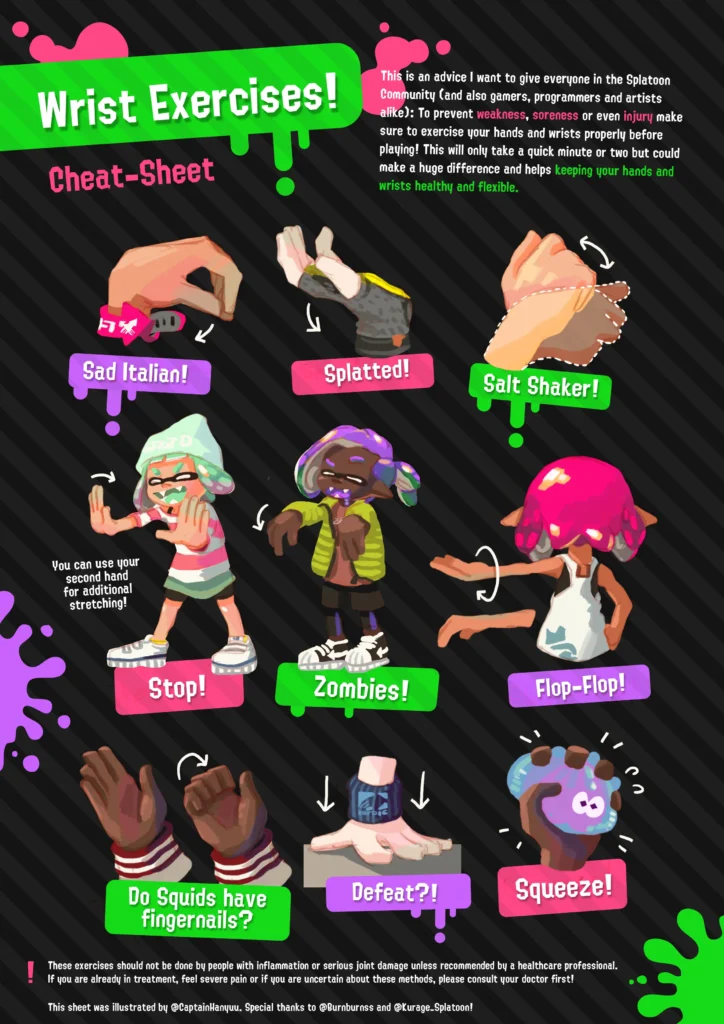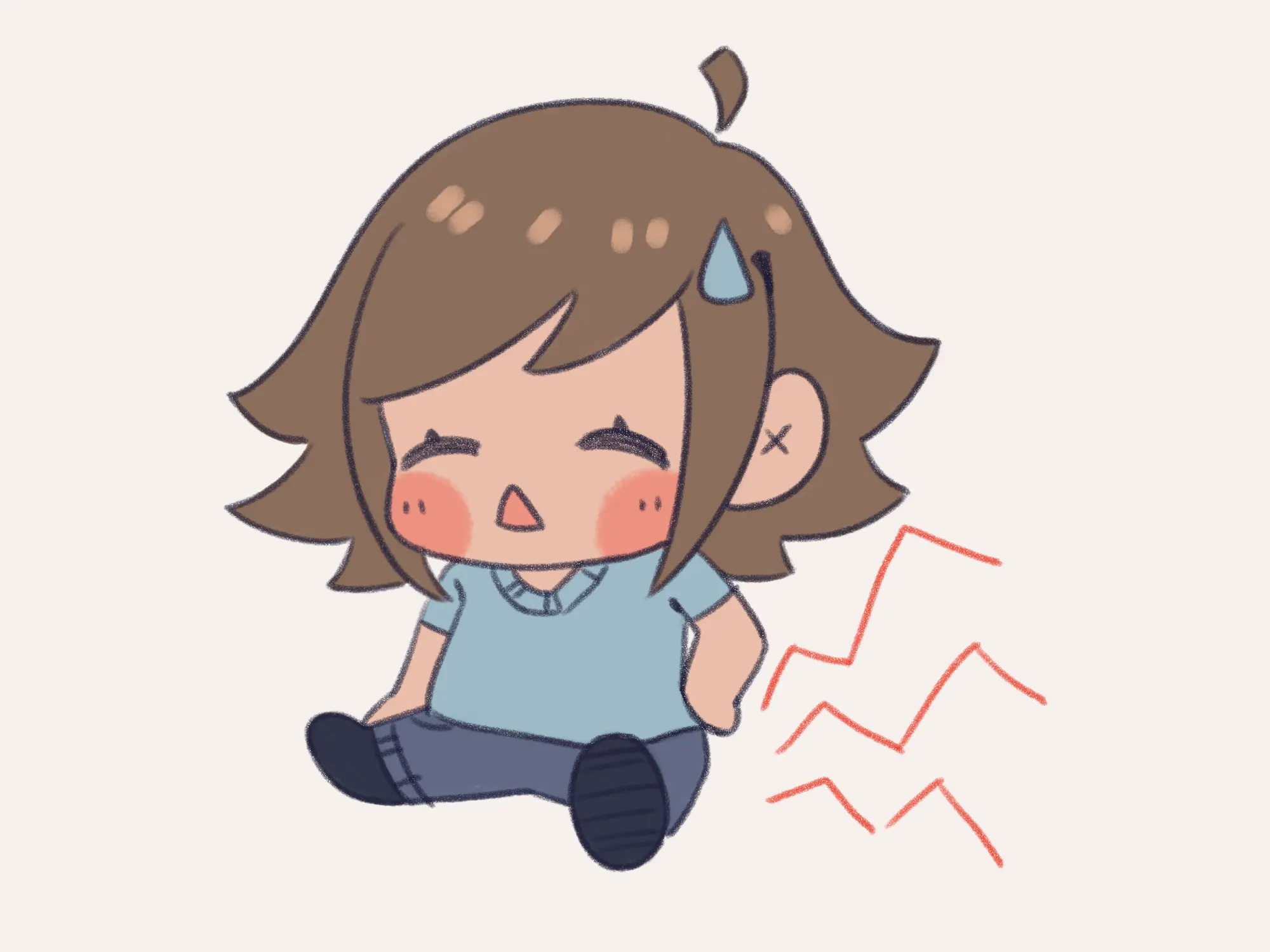
Easy Exercises to Combat Sitting All Day: Stay Active at Your Desk
TCC is reader-supported. This post contains affiliate links to products I have used and loved. If you click and make a purchase, I may receive a small commission at no extra cost to you. Thank you!
Sitting for long periods might feel inevitable in our line of work—most of us artists, editors, writers, streamers, and similar creatives spend a lot of time in front of our computers—but it can take a toll on your body. Research shows that prolonged sitting contributes to issues like muscle stiffness, lower back pain, wrist pain, and even fatigue (ever heard the phrase “sitting is the new smoking?”). Without regular movement, these problems can build up over time, leaving you uncomfortable, less productive, and, in worse cases, dealing with severe pain.
But hey, you don’t need to hit the gym to keep these issues at bay! You can incorporate small, simple exercises throughout your day, and they can make a world of difference. A few minutes of stretching, hand exercises, and eye breaks will help you stay energized, focused, and pain-free.
In this post, I’ll walk you through:
- Targeted stretches to prevent neck and back pain, wrist strain, and eye fatigue. If you’re feeling up to it, I’ve also included some seated and standing exercises you can do right at your desk.
- Helpful tools you can keep within reach—like stress balls and resistance bands—to support your movement breaks.
- How to use the Pomodoro method to stay active, incorporating short bursts of movement every hour.
These easy strategies are designed to be quick, effective, and achievable for anyone, no matter your workspace. Whether you’re working from home, at an office, or in between gaming sessions, these tips will help you stay comfortable and healthy throughout your day.
Common Physical Issues from Sitting All Day
Sitting for extended periods without movement can lead to a variety of physical issues. While the impact might seem minor at first—“My lower back hurts a little, but I’m okay”—these discomforts can build up over time. So, how exactly does a sedentary lifestyle affect your body?
- Leg and Glute Muscles: Prolonged sitting can cause these large muscles to weaken over time. Since they play a crucial role in walking and maintaining stability, muscle weakness increases your risk of injuries from falls or strains.
- Hips and Back: Just like your legs and glutes, your hips and back muscles can also deteriorate. Sitting for long periods compresses your hip flexors, causing them to shorten and leading to stiffness or joint problems. Without ergonomic support or proper posture, your spinal health may suffer, with compressed discs causing significant pain over time. Plus, a weakened core makes it harder to maintain good posture, which can contribute to chronic back pain.
- Stiff Neck and Shoulders: Poor posture—like hunching over your desk for hours—can lead to stiffness in your neck and shoulders, making it harder to move comfortably.
- Wrist Strain: Frequent typing, mouse use, or drawing for long periods can result in repetitive strain injuries (RSIs), which may lead to conditions like carpal tunnel syndrome. Don’t ignore wrist pain—take breaks for wrist stretches and hand exercises!
- Eye Fatigue: Staring at screens for extended periods can cause dry, strained eyes, a condition known as Computer Vision Syndrome. Symptoms include headaches, blurred vision, dryness, and a burning sensation. It can also disrupt your sleep patterns, especially if you work late at night.
- Weight Gain: Sitting slows digestion, which can lead to your body storing more fat and sugar. Even regular workouts may not offset the risks associated with long hours of sitting. Studies suggest you need 60–75 minutes of moderate-intensity exercise daily to counteract these effects. But if you’re thinking, “I don’t have the time or energy for that!”—me neither! Breaking up your sitting time with short walks is a much easier solution.
- Anxiety and Depression: While we understand the physical impacts of sitting better than the mental ones, studies suggest that extended sitting increases the risk of anxiety and depression. The lack of movement might deprive you of the mental and physical benefits that exercise provides, so adding more movement throughout your day can help improve your mood.
- Cancer: There are links between prolonged sitting and certain cancers—like colon, lung, and uterine cancer—though researchers are still trying to understand the connection.
- Heart Disease: Long periods of inactivity increase your risk of heart attacks or strokes by 147% and 90% increase in overall cardiovascular mortality. One study found that men who spent between 10 to 23 hours of sedentary behavior per week had a 64% – 82% higher risk of cardiovascular disease than those who spent between 4 to 10 hours or less without movement.
- Diabetes: Research shows that people who sit for long periods have a 112% higher risk of developing diabetes.
- Deep Vein Thrombosis (DVT) and Varicose Veins: Sitting too long can lead to DVT, a dangerous blood clot that forms in the legs and can travel to the lungs, potentially causing death. Varicose veins—those spider-like veins in the legs—aren’t usually dangerous but can also develop clots, posing a similar risk.
Pretty scary, huh? Don’t worry—there are steps you can take to prevent these issues. In the following sections, I’ll walk you through practical strategies, tools, and exercises to help you stay healthy and active, even when your job requires sitting all day. Plus, I’ve got a FREE Notion exercise/stretching guide you can keep in your digital workspace to stay on track. You can find the link further down in the post! 🙂
Simple Stretches to Prevent Sitting-Related Physical Issues
Incorporating simple stretches into your daily routine can significantly alleviate the physical issues that arise from prolonged sitting. Here are some simple stretches you can do in between breaks. If you click on the titles of the exercises, it will take you directly to a YouTube video demonstrating how to perform them safely.
Stretches for Back Pain Relief and Posture Improvement
Stand slightly away from your desk with your feet hip-width apart. Place your hands on the desk, then hinge forward from the hips, lowering your chest toward the floor. Keep your back flat and let your head relax between your arms. This stretch opens the shoulders, relieves tension in the lower back, and improves posture. (My personal favorite!)
Stand with your back against a wall. Raise your arms to shoulder height, keeping them pressed against the wall. Slowly slide your arms up and down while maintaining contact with the wall. This exercise activates your upper back muscles, improving posture.
Sit toward the edge of your chair with your feet flat on the floor. Inhale and tilt your pelvis forward, arching your lower back slightly. Exhale and tilt your pelvis backward, rounding your lower back. This movement helps strengthen the core and release tension from the lumbar spine. (a little bit like cat cows! But more focus on your pelvis)
Gently tilt your head side to side, as if saying “yes” slowly. Then, tilt it left to right, mimicking the word “no.” Finish with semi-circles in a rainbow pattern to relieve neck tension.
Sit or stand comfortably and roll your shoulders forward in a circular motion for a few seconds, then reverse the direction. This stretch reduces shoulder stiffness and promotes relaxation in the upper body.
Wrist and Hand Stretches to Combat Strain
Extend your arms in front of you and make slow circular motions with your wrists—first clockwise, then counterclockwise. Repeat for 10 circles in each direction to release tension and improve wrist flexibility.
Finger Extensions with a Stress Ball
Hold a stress ball in one hand and squeeze it tightly for a few seconds before releasing it. Repeat 10-15 times for each hand to strengthen hand muscles and improve grip strength.
Place your palms together in front of your chest. Gently push downward to stretch your wrists and forearms. Hold for a few seconds to relieve tension from typing or drawing.
Eye Exercises to Reduce Fatigue
20-20-20 Rule
Every 20 minutes, look at something 20 feet away for 20 seconds to reduce eye strain from screen time.
Palming Technique
Rub your hands together to generate warmth, then gently place them over your closed eyes. Relax and breathe deeply for 30 seconds to relieve tension in the eye muscles. If you wear glasses, remember to take them off or slide your hands under them—I’ve lost count of how many times I’ve placed my hands on my glasses by accident!
Blink Breaks
We often stare at our screens without realizing how little we blink! If you tend to hyperfocus (like drawing for an hour straight with your face an inch from the screen), listen to your body. When your eyes feel dry, achy, or irritated, take a moment to blink consciously and rehydrate them.
If you need more ideas, check out my 10-Minute Desk Break blog post!
>> Top 10 Ways to Maximize Your 10-Minute Work Breaks
Let me wrap up this section by addressing sitting posture. The perfect sitting position does NOT exist. We often imagine an ideal S-curve back posture with a perfectly straight back, but every position has its trade-offs, working different muscles in the process. The key to maintaining a healthy lower back and pelvis is changing positions throughout the day. By shifting how you sit, you avoid overloading the same muscles and give others a chance to engage.
Personally, I switch things up all the time. I’ll keep my back straight for a bit, then sit cross-legged, or stretch my legs out super wide (yes, I know, “you’re not supposed to do that as a lady”—but who cares?). I’ll slouch for a while, sit with my legs tucked under me, or lean to one side and then the other. Sometimes, I even twist my legs up like a pretzel, whatever feels good at the time.
The goal is to keep your body moving—constantly switching positions prevents your lower muscles from bearing the same pressure for too long. So, experiment with your sitting posture and see what works for you!
Quick Desk Exercises
Besides stretching your muscles, which promotes relaxation and flexibility, adding bodyweight exercises or ankle weights will strengthen your muscles and bones, helping prevent injuries and build stability. Here are some effective exercises you can do right at your desk!
Seated Exercises
Extend both arms toward the ceiling, then lower them as you bend down to touch the floor. Repeat this cycle a few times. For an extra challenge, try adding wrist weights.
Place your hands by your head with your elbows wide open. Lean forward and bring your right knee in, trying to touch your left elbow to your right knee. Switch sides and repeat the movement.
Lift your knees alternately as if you’re marching in place. Keep your back straight and engage your core. Aim for a steady pace, and use ankle weights to increase the intensity.
Standing Exercises
Stand a few feet away from your desk, facing it. Place your hands shoulder-width apart on the edge of the desk and keep your body straight. Lower your chest toward the desk, then push back up. Aim for 10-15 reps. If this feels challenging, try wall push-ups instead.
Stand up straight and slowly rise onto your toes, lifting your heels off the ground. Hold for a few seconds, then lower your heels back down. Repeat 15-20 times.
Find a clear wall space and stand with your back against the wall. Slide down until your thighs are parallel to the floor, keeping your back flat against the wall. Hold this position for as long as you can, then rest and repeat 2-3 more times.
If exercises aren’t for you, check out my blog post all about walking! Walking is another fun and easy way to add movement to your day.
Easy ways to be active during your day to day life
- When you are cleaning up, put items away in small trips rather than taking them all at once.
- Walk around when you’re on the phone.
- Instead of sitting down to read, listen to audiobooks while you walk, clean, or work in the garden.
- Stand up while reading emails.
- Move your trash bin away from your desk so you have to get up to throw something away.
- Use a smaller water bottle so you have to stand up to refill it more often.
- Incorporate active games like tag, hide and seek, or fetch with your family and pets.
- Learn a new dance routine every week or every other week. There are plenty of tutorials on YouTube for your favorite songs!
- Try following a yoga or Pilates video. (My current favorite are the silly 80’s workout videos. equal parts fun and function)
- If possible, swap to a standing desk so you can alternate between sitting and standing while staying productive.
- Keep items you frequently use (like pens or Post-it notes) just out of reach so you have to get up to access them.
- Create a movement calendar. You can try different types of movement on different days, like “Resistance Band Fridays,” “Yoga Mondays,” or “Dance Wednesdays.”
- Create a challenge for yourself. the “30 second plank challenge” or the “100 jumping jacks challenge”, see if you can beat your previous record.
- Shadow boxing. Let that stress out! punch the air!
Tools to Keep at Your Desk for Active Breaks (aka your fun movement basket!)
Equipping your workspace with the right tools can make it easier to incorporate movement and promote overall well-being throughout your day. I like to keep some of these smaller items in a super cute basket I found at my local dollar store, and most of these tools are in pink! They make me happy to use them.
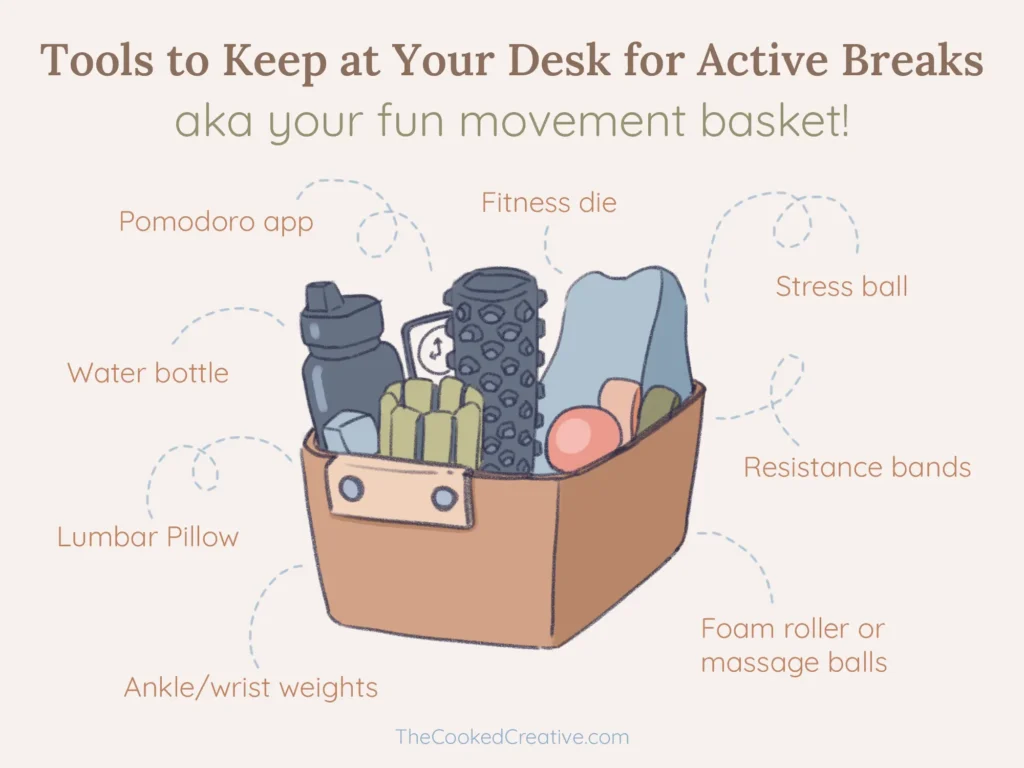
Stress Balls
Squeezing a stress ball not only relieves tension but can also strengthen your hand and forearm muscles while providing a satisfying way to release stress. Keep one by your desk for easy access.
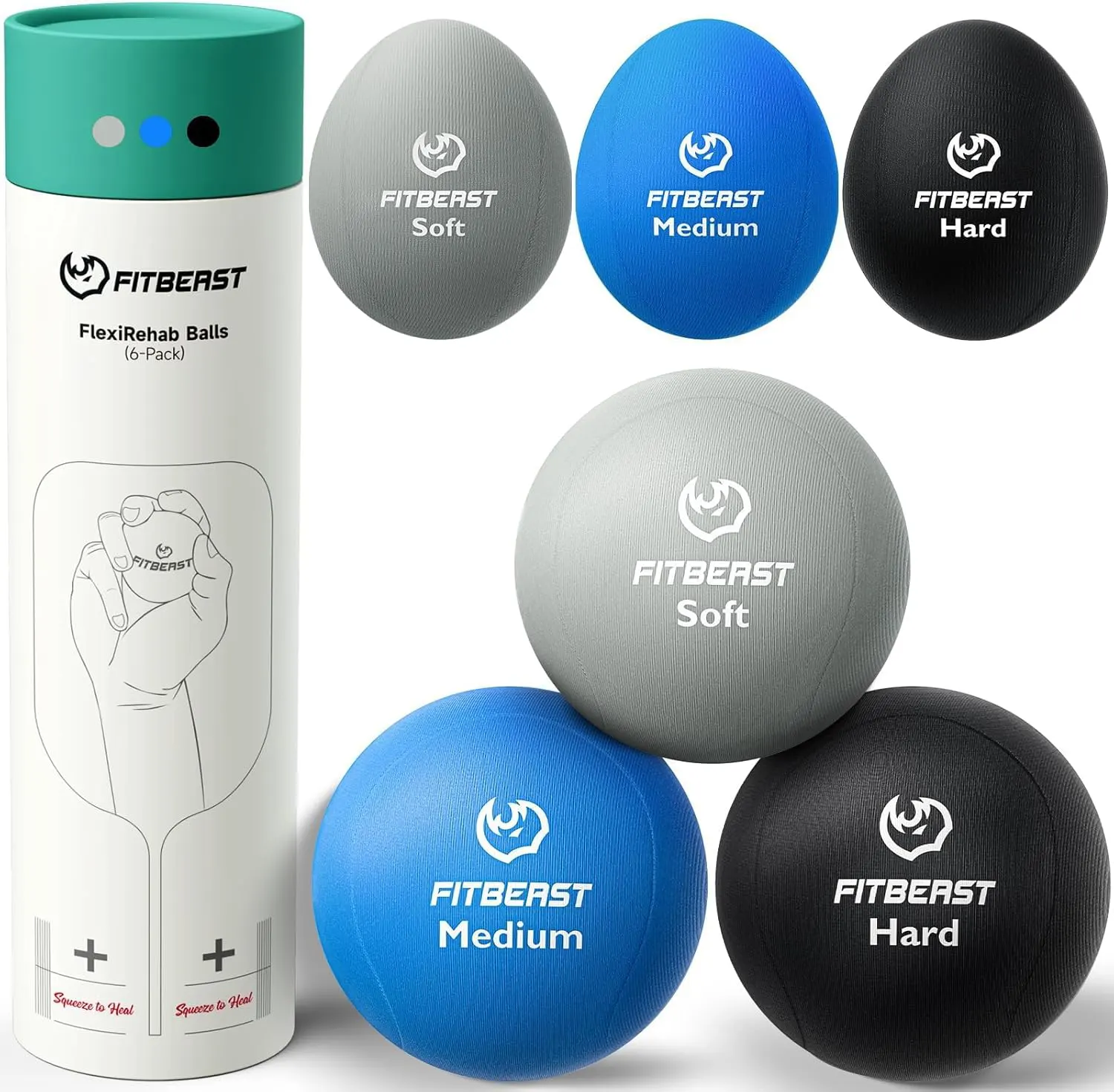
Crafted with tear-resistant, non-slip materials, these hand therapy balls ensure durability and comfort. Includes 3 egg-shaped and 3 round stress balls, each available in Soft, Medium, and Hard resistance levels.
You can buy them in different colors, the pastel set is BEAUTIFUL!!!
Resistance Bands
Resistance bands are lightweight and versatile, making them easy to incorporate into your routine for strength exercises without having to leave your desk area if you don’t have much space. Use them for seated leg presses/raises, bicep curls, pull-aparts, or even shoulder presses. They offer adjustable resistance levels, making them convenient to use at any time.
I like using longer resistance bands because I find them very versatile, but if you don’t have much storage space you can opt for the smaller ones, both have lots of uses!
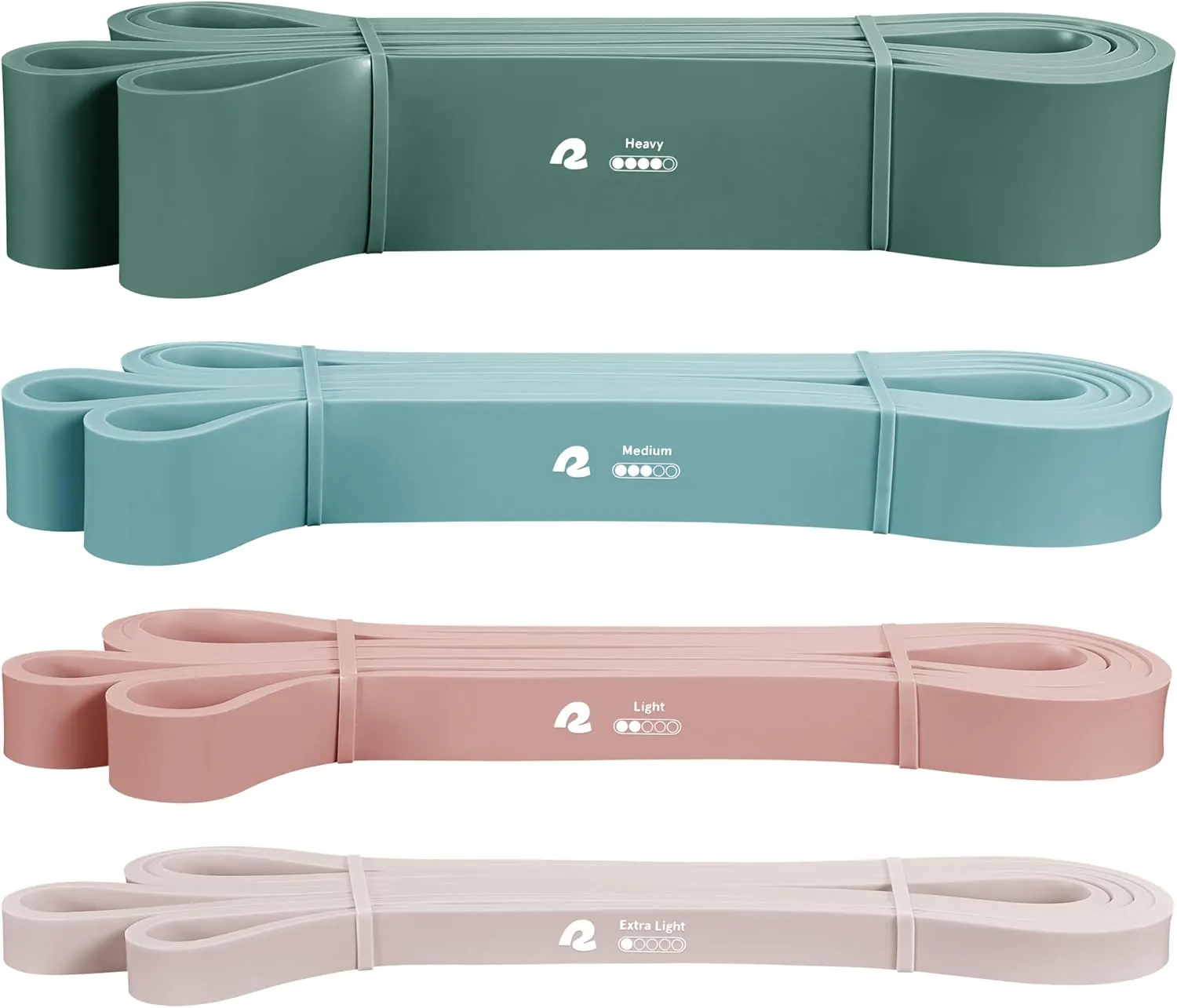
The set includes four bands of varying levels of resistance: Extra Light (15-35 lbs), Light (25-65 lbs), Medium (35-85 lbs), and Heavy (50-125 lbs). Versatility for Any Workout These resistance bands add resistance to a variety of different exercises to target specific muscle groups and intensify your workouts. Great for assisted pull-ups, chin ups, front & lateral raises, core & total body exercises, stretching, mobility, and more!
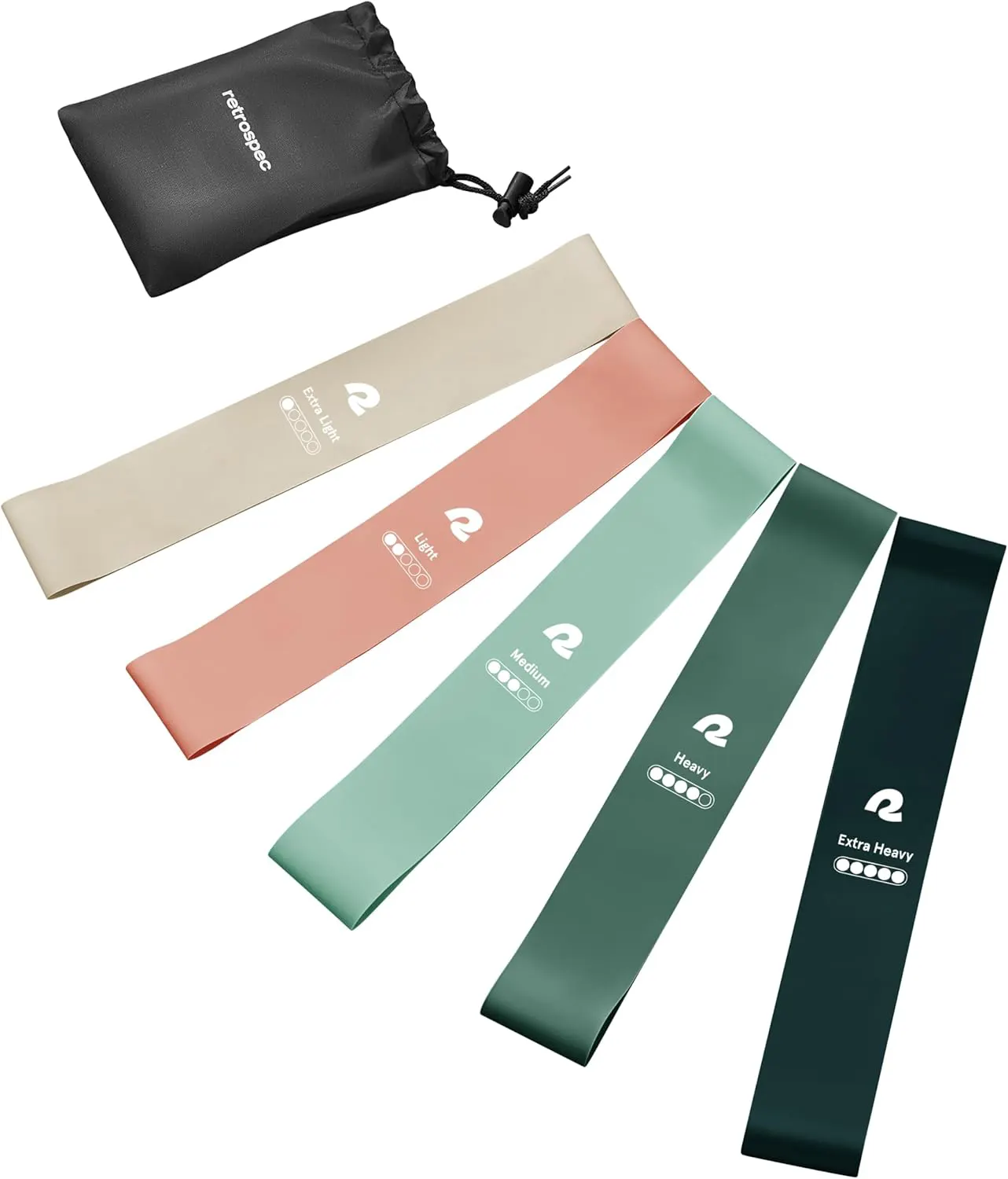
These loop bands come in a set of five weights: Extra Light (2-4 lbs), Light (6-8 lbs), Medium (10-12 lbs), Heavy (15-20 lbs, and Extra Heavy (25-30 lbs). hese resistance bands add resistance to a variety of different exercises to target specific muscle groups and intensify your workouts. Great for strength & stability training, toning, stretching & mobility exercises, muscle endurance, and more!
Foam Roller or Massage Balls
These can provide muscle relief during your breaks. Use them to roll out tight muscles in your back, legs, or arms; they help alleviate soreness and tension. Just a few minutes of foam rolling can enhance your comfort while working.
Ankle or Wrist Weights
These are a fantastic addition to your desk toolkit, allowing you to add resistance to your movements without requiring extra space. You can use them while standing on side lifts or in arm circles. This extra weight can help make your active breaks more effective.
Posture Corrector or Lumbar Support Pillow
Remember my little sitting position spiel? A lumbar support pillow is super helpful when you want to maintain a “proper” posture for a moment; I like to use it on and off. It brings extra comfort when I need it; however, I do not recommend using it for the entire time you spend sitting. Shoutout to donut seat pillows for butt support! Another great tool to have at your disposal for when you need it.
Water Bottle or Hydration Reminder Device
Keep a water bottle by your desk to remind you to drink throughout the day! Consider using a reminder device or an app that alerts you to take regular sips, ensuring you stay refreshed and focused. Extra tip:
Pomodoro App or Physical Timer
A timer can be a valuable tool for managing your work and break intervals. There are different timer modalities; I personally use 45 minutes of work followed by a 10-minute break. You can set the time that works for you, as long as your work time isn’t longer than an hour. This will ultimately enhance productivity and reduce fatigue while reminding you to take active breaks regularly.
A Pair of Dice
Including a fitness die is a fun way to randomize your movements and keep each break different. If you can’t find a fitness die but have two regular six-sided dice (d6), you can use the table below!
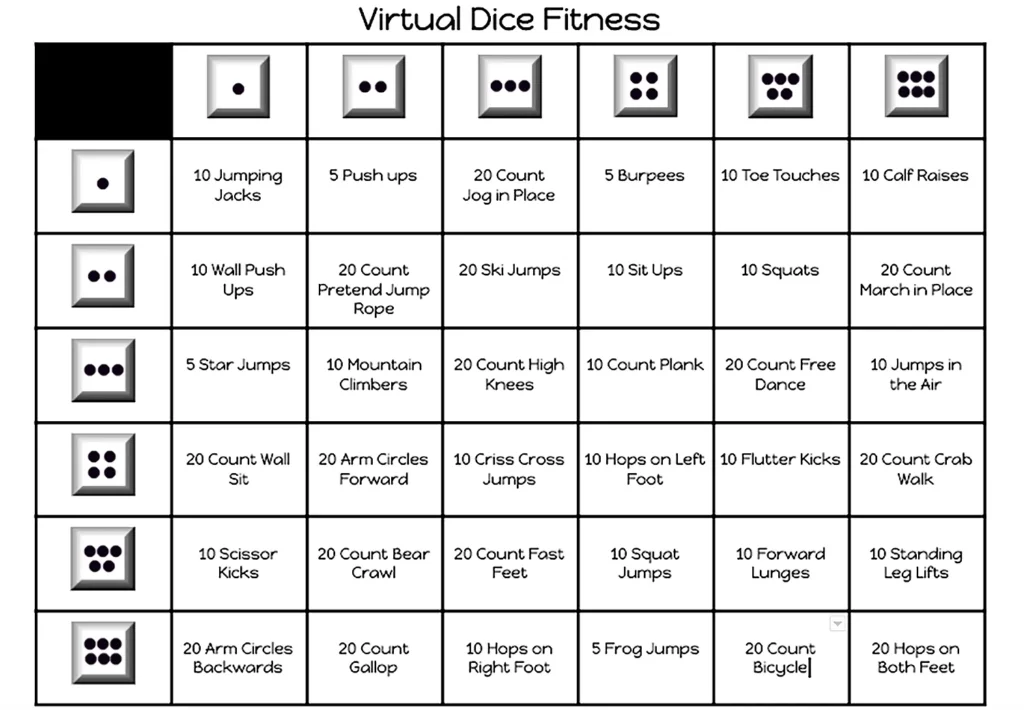
Table from here!
Tips for Building a Sustainable Movement Routine
Small, intentional changes have the most lasting impact on your health. Building a routine doesn’t have to be overwhelming! I have some practical tips you can start with right away:
- Set reminders: It’s easy to lose track when you’re focused on work, so use timers or remind yourself to move every hour (back to my beloved Pomodoro!). This will help you build a habit of moving more regularly.
- Track your progress: Keeping a habit tracker or a journal for your movement goals can keep you motivated. Whether it’s marking off each hour you move or logging which exercises you did, tracking your progress helps you stay accountable and see how far you’ve come. You can use apps, printable habit trackers, or even a simple notebook.
- Start small: You don’t need to dive into an intense workout right away. Start by adding one or two exercises per day to get into the habit of moving. Once it becomes part of your routine, you can gradually add more exercises or extend your active break time.
- Combine exercises with fun: Make movement enjoyable by pairing it with something you like. You can listen to your favorite playlist, catch up on a podcast, listen to an audiobook, or watch short videos during your active breaks. This makes moving feel less like a chore.
I’ll share my own movement routine in case you need ideas on how to structure yours; feel free to use mine as a template!
I work out for an hour Monday through Friday. After doing some chores, taking a shower, and having breakfast, I start my workday. The first thing I do is set up my Pomodoro timer. I personally use the game Spirit City: Lofi Sessions on Steam. It’s very motivating for me to create my own character, design my room based on the season or my mood, and have a Pomodoro timer and to-do list all in one place. I keep the game open in a corner of my second monitor to maintain those cozy vibes!
During every 10-minute break, I get up and walk. I have a small house, but fortunately, I have a patio where I like to garden. I walk around my plants to make sure they are doing okay, water them, and prune some. I also live with 12 cats, and going around my house to try to find all of them is super fun. If it’s raining or too sunny outside, I try to clean, declutter, and do some chores around the house, take a bathroom break, or walk some laps around my dining table.
Once I sit back down, before starting my next work hour, I do some stretches or grab a random item from my movement basket. It feels so good to relieve muscle tension right before work, as it keeps me focused and feeling refreshed once I start working. Rinse and repeat!
At the end of the day, I clock out of work and move from my work office to my room (I work from home!) and I shake my entire body. I like to think I’m “shaking work off,” and it’s really fun too! I listen to a quick guided meditation to truly disconnect from work, and then I do some “mobility drills.” I have them separated into categories (just to make it more fun, my categories are modeled after a menu! I have upper body stretches as my “Entrée” and twist/rotation movements as the “Main Dish.” I also included a soup and a dessert. That way, I create my own “mobility menu,” and it keeps things super fun for me!) I just pick 1 or 2 movements per category and run through them. They take me anywhere from 5 minutes to half an hour! Sometimes I don’t have the time, and some twists and bends are enough; other times, if my back is hurting, adding some extra moves feels so good, and after 30 minutes, I feel like new.
I end my night by reading, and that’s it!
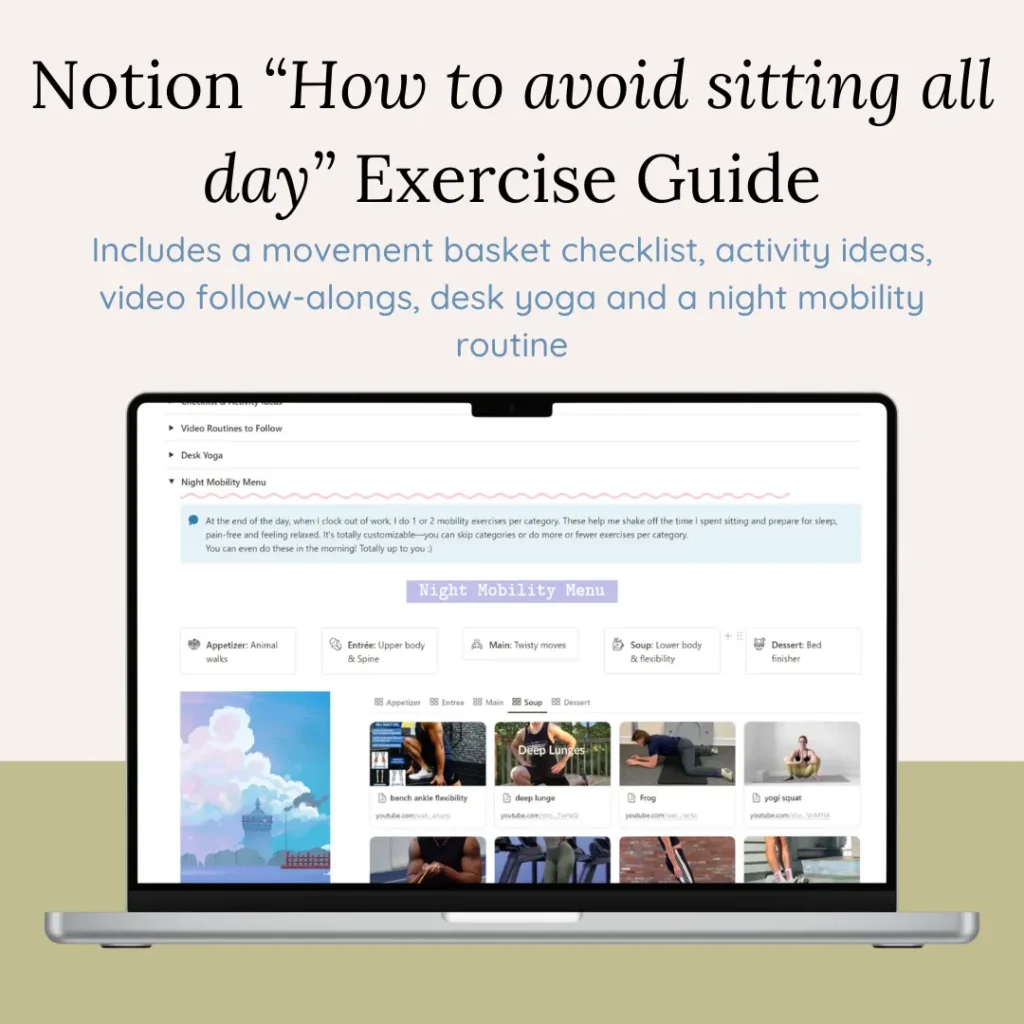
FREE Notion Exercise guide
Join my newsletter to gain access to my Freebie Library!
You’ll find my notion Exercise guide featuring my mobility menu alongside workbooks, stickers, wallpapers, and more ♡
Final thoughts
Staying active to counteract the effects of sitting for long periods of time is essential, especially when our jobs require a lot of sitting, focusing, and screen-staring.
With simple exercises, helpful desk tools, and regular Pomodoro breaks, it’s easier to make movement a natural part of your workday.
What is your next step? Try out a couple of these exercises today and notice the difference in how you feel. Small actions add up! What if your favorite way of movement? Comment down below! I personally like stretching and walking the most 🙂
If this article made things easier for you, I’d love it if you shared it with your friends and anyone who might need it!
Dont forget to follow me on social media for fun sneak peeks, behind the scenes and art! links on the sidebar.
Feeling Inspired? Here’s Some Extra Fun Stuff!
- 8 Inspiring Tips to Create a Healthier, Balanced Autumn Routine
- Foods for Creativity: A Multisensorial Experience



